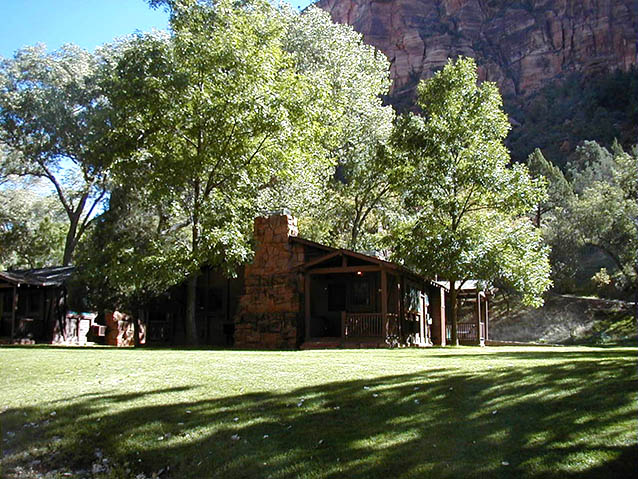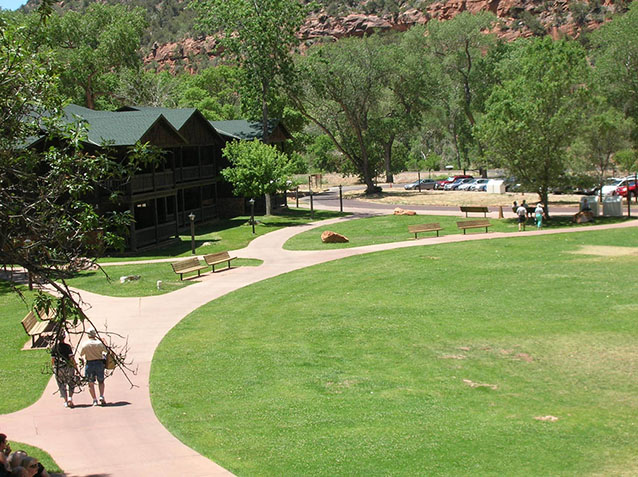Zion Lodge and Birch Creek, though not contiguous, represent a unified phase of development in Zion National Park by the historic concessionaire, the Utah Parks Company. Construction of the buildings and landscape features within the area began in 1924 and continued through 1937.
The Historic District was the product of a partnership between the National Park Service, the state of Utah, and the Union Pacific Railroad, formed in order to develop southern Utah and northern Arizona for tourism.

NPS
Prior to the development of this area, National Park Service Director Stephen Mather approached the Union Pacific Railroad with the suggestion that they invest substantially in Zion and control all the concession facilities in the park. Mather preferred that one large company control concession operations rather than a number of competing firms. Railroad/concession monopolies had been effective at other national parks, providing quality services while assisting the NPS in promoting the developing parks.
In 1923 the Union Pacific Railroad formed a subsidiary, the Utah Parks Company, to develop tourism in this scenic region. The leaders of the Utah Parks Company envisioned an enhanced “Grand Loop” tour of national parks in the region with improved roads, accommodations, and other tourist facilities. Once the Utah Parks Company had been awarded the contract for tourist accommodations at Zion, it purchased the canyon property of the Wylie Permanent Camping Company and began planning for its redevelopment.

NPS
The Zion Lodge was a key component of this new system of infrastructure. In 1924-1925, the Utah Parks Company designed and built the Zion Lodge complex very close to the site of the former Wylie camp. Accommodations consisted of a large central lodge building surrounded by a number of rustic cabins.
Between 1926 and 1928, the Utah Parks Company constructed the Birch Creek utility area on a site farther down the canyon. Equipped with a powerhouse (which no longer exists), horse barn, corral, maintenance garage, and a blacksmith shop, this utility area was built to support concession operations in the canyon. Perhaps most notably, the concessionaire sheltered its vehicles on-site. In 1925 the Utah Parks Company purchased a fleet of buses to transport tourists between its holdings in the parks and other parks and monuments of the region. These buses were equipped with removable tops so that visitors could better view the scenic wonders of the region.

NPS
The Zion Lodge/Birch Creek Historic District is significant for its association with events that contributed to the patterns of state history. The district is also associated with important architects and landscape architects, namely Gilbert Stanley Underwood and Daniel Hull. These two practitioners helped advance the NPS-Rustic Style in the park, which promoted a design that harmonized with the surrounding landscape through the use of local building materials.

NPS
The cultural landscape is also significant because it embodies the distinctive characteristics of a type and period of park development, as well as a particular style of architecture and landscape design. The Zion Lodge complex was built as part of an emerging nationwide model for tourist accommodations which the NPS followed for many years. In its integration of building and landscape design, it reflects the National Park Service’s increased commitment to park planning during the 1920s.
On a regional scale, the Zion Lodge/Birch Creek cultural landscape is significant for its association with the rise of tourism in southern Utah and northern Arizona through the establishment of a “Grand Loop” tour of national parks and monuments. This network of parks and tourist facilities came about through a partnership between the federal government and the Union Pacific Railroad.
Quick Facts
- Cultural Landscape Type: Designed
- National Register Significance Level: National
- National Register Significance Criteria: A, B, C
- Period of Significance: 1924-1937
Landscape Links
Last updated: January 15, 2020
